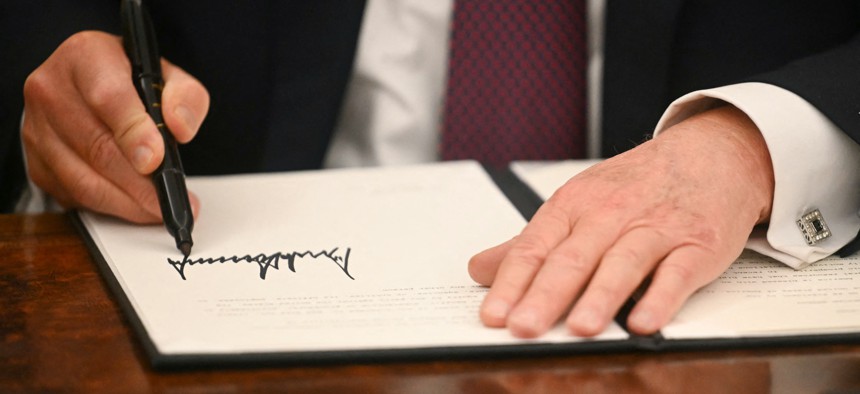
President Donald Trump signs executive orders in the Oval Office of the White House on Jan. 20, 2025. The president's most recent executive order requires agencies to create a strategic hiring committee to approve “the creation or filling” of each vacancy within the organization. JIM WATSON / Getty Images
Trump’s latest order requires strategic plans reflective of presidential ‘priorities’ to resume hiring
While experts agree that agencies should seek to address new skills gaps created by the Trump administration’s efforts to downsize the federal workforce, language enshrining “administration priorities” into those plans could politicize hiring of career workers.
President Trump on Wednesday signed a new executive order effectively indefinitely extending the ongoing hiring freeze, albeit while creating new requirements for federal agencies to obtain exceptions as well as new opportunities to politicize the federal workforce.
Trump’s hiring freeze, first implemented on Jan. 20, was set to expire Wednesday. The new order, entitled Ensuring Continued Accountability in Federal Hiring, requires agencies to create a strategic hiring committee, whose membership should include the deputy agency head and the agency head’s chief of staff, to approve “the creation or filling” of each vacancy within the organization. It also requires the creation and submission to both the Office of Personnel Management and the Office of Management and Budget of an annual staffing plan.
“In these plans, agencies shall seek to improve operational efficiency; eliminate duplicative or unnecessary functions and positions; reduce unnecessary or low-value contractor positions; promote employee accountability; enhance delivery of essential service; appropriately prioritize hiring for national security, homeland security and public safety positions; and implement the recruitment initiatives described in the merit hiring plan,” the order states. “Going forward, agencies shall prepare, in coordination with OPM and OMB, annual staffing plans to implement at the start of each new fiscal year.”
The provisions of the executive order do not apply to any political appointments in government, or to active duty military, positions related to immigration enforcement, national security or public safety or in any hiring decisions “authorized by the head of an executive department.”
Ron Sanders, a fellow at the National Academy of Public Administration and former federal HR leader, said that while it makes sense to assess what skills gaps exist following the mass departure of civil servants through the Deferred Resignation Program, probationary purges and other early-term efforts by the Trump administration to reduce the size of the federal workforce, agencies have been developing strategic hiring and staffing plans “for decades.”
“It surprises and bothers me that we apparently needed an executive order to tell my professional colleagues to do what, frankly, they should have been doing in the first place in creating hiring plans. Every agency has one,” he said. “[So] one of two things are happening here: either the agencies didn’t have those plans, which is very, very problematic but almost likely a null set, or the politically appointed agency heads were not talking to their career folks. Both sides can point the finger with regard to the distrust there, and there’s been a lot of that going around, but all of that is beside the point because at the end of the day, the EO says to do things you should have been doing all along.”
But Don Kettl, professor emeritus at the University of Maryland and former dean of its School of Public Policy, said the edict’s demand that hiring decisions are “consistent with the national interest, agency needs, and the priorities of my administration"—seemingly down to the filling of individual vacancies—could mark a “draconian” push toward politicizing the career civil service.
“On the one hand, it could be read fairly modestly as a way to ensure individual hires are consistent with the hiring plan,” he said. “But ‘the priorities of my administration’ could easily be read as requiring personal loyalty to the president. It’s unlike anything I’ve ever seen in any hiring or merit system document whatsoever . . . I’ve talked so some folks who have been working on this for a long time, and they don’t see a distinction between hiring based on merit or based on patronage.”
Sanders said that while the order’s language creates the “potential” for politicization—and that potential is much higher under Trump than previous administrations—ultimately, agencies will still need strong job applicants to fulfill their missions and their leaders will be held accountable by lawmakers, judges or the voters.
“There is certainly the potential for partisanship, maybe even extreme potential in this case,” he said. “But there’s also the seeming acknowledgement of distrust between agencies’ political and career leaders. The good news is if I were a career CHCO, I’d use this as a vehicle to at least begin to deal with that distrust from my side.”
Share your news tips with us: Erich Wagner: ewagner@govexec.com; Signal: ewagner.47
NEXT STORY: Trump admin vows to follow court order on layoffs, but some cuts may still be imminent







